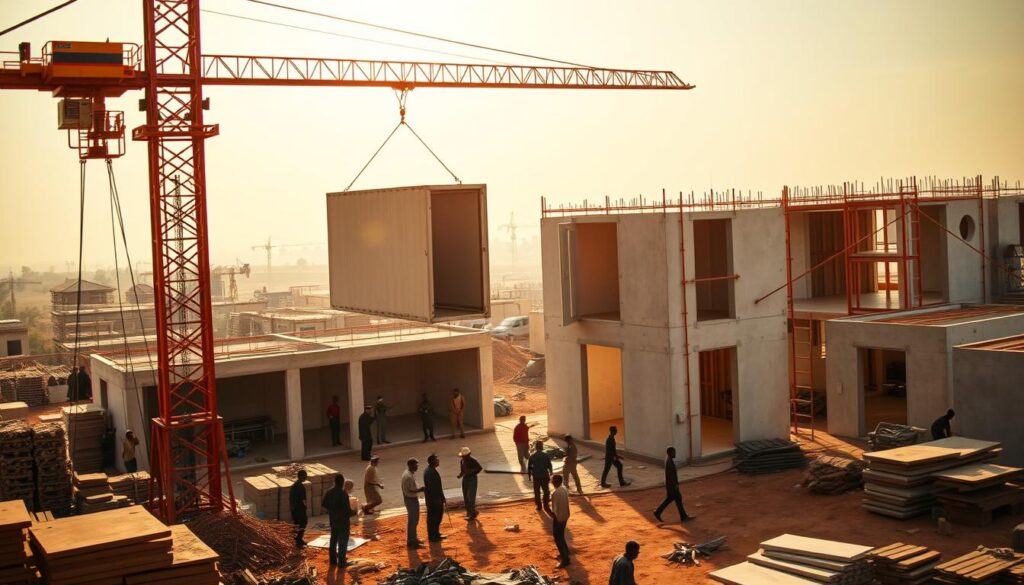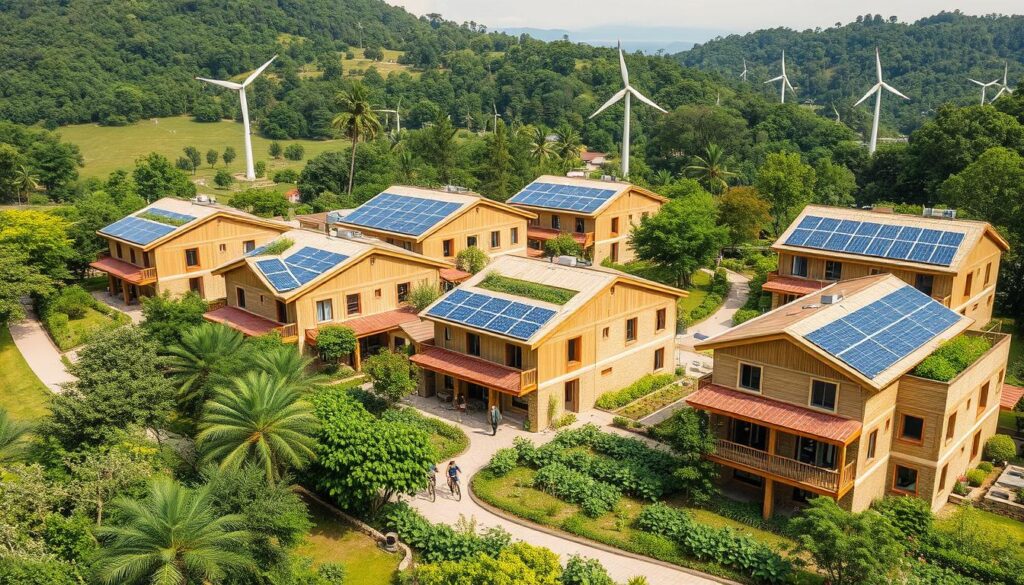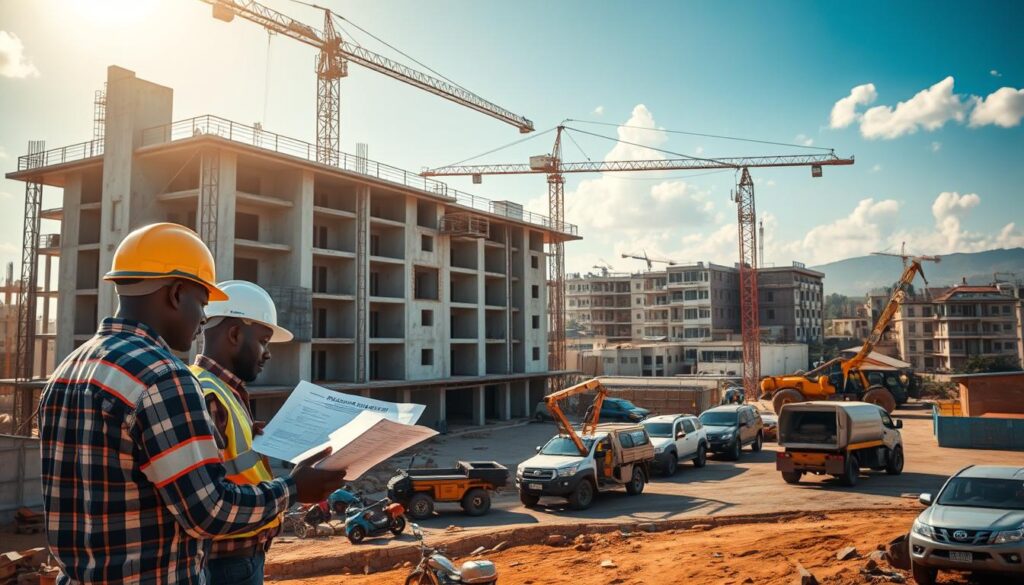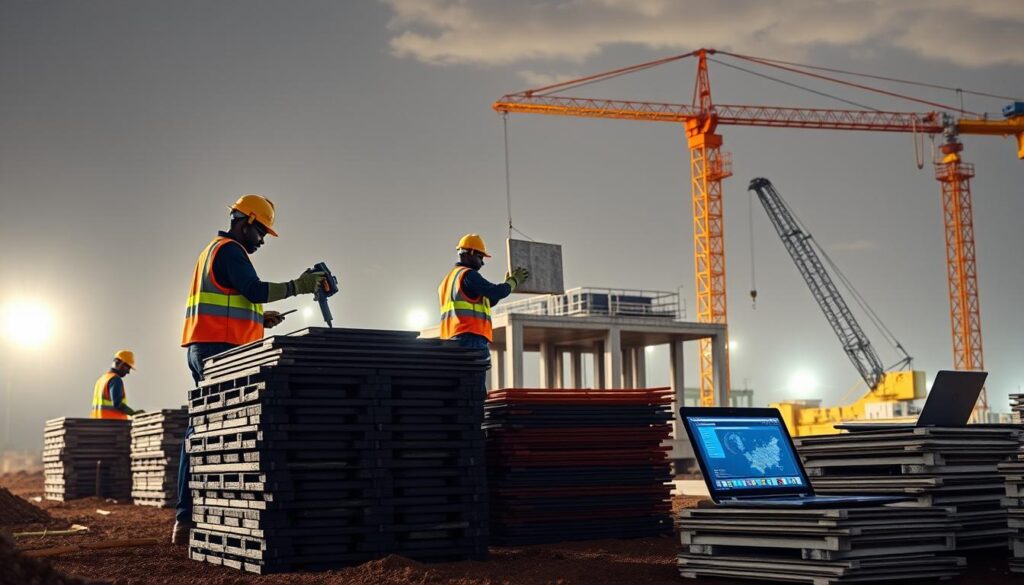Can infrastructure development in Africa be achieved without breaking the bank? With the rising demand for cost-effective construction methods, this question is on the minds of developers, contractors, and investors alike.
The answer lies in implementing effective construction cost reduction strategies. By optimizing costs, stakeholders can ensure that projects are completed within budget without compromising on quality.
As the demand for infrastructure continues to grow, understanding how to cut construction costs is crucial. This guide will explore various methods to achieve this goal, providing valuable insights for stakeholders in the construction industry.
Key Takeaways
- Effective strategies for reducing construction costs
- Methods for optimizing construction projects
- Best practices for cost-effective construction
- Key considerations for infrastructure development
- Benefits of implementing cost reduction strategies
Understanding the Construction Landscape in Africa
Africa’s construction landscape is evolving, driven by the need for modern infrastructure and sustainable building practices. This transformation is characterized by the adoption of innovative technologies and materials, alongside traditional construction methods.
Current Trends in African Construction
The African construction industry is witnessing a significant shift towards cost-effective construction methods. This includes the use of locally sourced materials, prefabricated building components, and modular construction techniques. Such trends not only reduce construction costs but also enhance the sustainability of building projects.
Moreover, there’s a growing emphasis on incorporating green building practices into construction projects. This involves using energy-efficient designs, renewable energy systems, and materials that minimize environmental impact. As a result, buildings are becoming more sustainable and environmentally friendly.
Key Challenges Facing the Industry
Despite the positive trends, the African construction industry faces several challenges. Regulatory hurdles, logistical issues, and the need for skilled labor are some of the key obstacles. For instance, navigating the complex regulatory environment in different countries can be daunting for construction companies.
Additionally, logistical challenges such as inadequate infrastructure and supply chain inefficiencies can significantly impact project timelines and costs. Addressing these challenges is crucial for optimizing Africa construction cost optimization and ensuring the successful completion of construction projects.
Importance of Budgeting in Construction Projects
In the context of African construction, creating a realistic budget is essential for project viability. Construction projects involve numerous variables and unforeseen expenses, making budgeting a critical component of project planning.
Effective budgeting helps in reducing building expenses in Africa by identifying areas where costs can be minimized without compromising the quality of the project. It involves understanding the costs associated with materials, labor, and equipment, as well as anticipating potential risks and developing mitigation strategies.
Creating a Realistic Budget
To create a realistic budget, several factors must be considered:
- Accurate estimation of material and labor costs
- Understanding of local market conditions and their impact on costs
- Identification of potential risks and development of contingency plans
- Inclusion of a buffer for unforeseen expenses
By considering these factors, construction companies can develop affordable building solutions that meet their clients’ needs while ensuring profitability.

Tracking Expenses Effectively
Tracking expenses is crucial to ensuring that a construction project stays within budget. This involves:
- Regular monitoring of expenses against the budget
- Implementation of a robust accounting system to track costs
- Identification and addressing of cost overruns promptly
Effective expense tracking enables project managers to make informed decisions and take corrective actions when necessary, ultimately contributing to reducing building expenses in Africa.
Leveraging Local Resources and Materials
One of the most effective strategies for reducing construction costs in Africa is leveraging local resources and materials. By doing so, construction projects can benefit from lower transportation costs, faster delivery times, and a reduced carbon footprint.
Advantages of Using Local Suppliers
Using local suppliers for construction materials offers several advantages. Firstly, it significantly reduces transportation costs, as materials do not need to be shipped over long distances. Secondly, local suppliers can provide materials more quickly, helping to keep projects on schedule.
Key benefits of local suppliers include:
- Faster delivery times
- Lower transportation costs
- Support for the local economy
- Easier communication and negotiation
How to Source Sustainable Materials
Sourcing sustainable materials is not only beneficial for the environment, but it can also lead to long-term cost savings. To source sustainable materials effectively, consider the following strategies:
| Material | Sustainable Alternative | Cost Savings |
|---|---|---|
| Traditional Timber | Reclaimed or Bamboo Wood | Up to 20% |
| Standard Concrete | Low-Carbon Concrete | Up to 15% |
| Conventional Insulation | Recycled or Natural Insulation | Up to 25% |
By adopting these strategies and leveraging local resources and materials, construction projects in Africa can achieve significant cost savings while promoting sustainability.
Innovative Building Techniques to Cut Costs
Innovative building methods are revolutionizing the African construction landscape by cutting costs and enhancing efficiency. The traditional construction methods are being complemented by modern techniques that not only reduce expenses but also improve the quality and speed of project completion.
Prefabrication Methods
Prefabrication involves manufacturing building components in a factory before transporting them to the construction site. This technique significantly reduces on-site labor costs and minimizes waste, thereby contributing to cost savings. Prefabrication also enhances quality control as components are manufactured in a controlled environment.

The use of prefabricated components can accelerate the construction process, as site preparation and component manufacturing can occur simultaneously. This method is particularly beneficial in areas with challenging weather conditions or limited skilled labor.
Modular Construction Benefits
Modular construction takes prefabrication a step further by constructing entire modules or rooms in a factory. These modules are then assembled on-site to form the complete building. This technique not only reduces construction time but also cuts costs by minimizing on-site labor and reducing material waste.
Modular construction offers several benefits, including:
- Improved quality control due to factory-based manufacturing
- Reduced environmental impact through minimized waste and controlled material usage
- Enhanced safety as a significant portion of the work is conducted in a controlled factory environment
By adopting innovative building techniques like prefabrication and modular construction, African construction projects can achieve significant cost savings while improving efficiency and quality.
Technology’s Role in Cost Reduction
In the quest for cost-effective construction methods, the African construction sector is increasingly turning to technology. The integration of various technological tools is not only enhancing project management but also significantly reducing costs.
Construction management software is at the forefront of this technological revolution. It enables project managers to plan, track, and execute projects more efficiently. By utilizing such software, construction companies can streamline their operations, reduce paperwork, and improve communication among teams.
Utilizing Construction Management Software
Construction management software offers a range of benefits, including:
- Enhanced project planning: Allows for detailed scheduling and resource allocation.
- Real-time tracking: Enables monitoring of project progress and immediate identification of potential delays.
- Improved collaboration: Facilitates communication among different stakeholders, ensuring everyone is on the same page.
By adopting construction management software, African construction companies can optimize their projects, leading to cost savings and improved efficiency.
The Impact of Drones and AI on Efficiency
Drones and Artificial Intelligence (AI) are transforming the construction landscape. Drones are used for site surveys, monitoring progress, and inspecting hard-to-reach areas, while AI algorithms can analyze data to predict potential issues and suggest corrective actions.
The combination of drones and AI can lead to:
- Accurate site surveys: Reducing the need for manual surveys and enhancing data accuracy.
- Predictive maintenance: AI can analyze data from drones and other sources to predict and prevent equipment failures.
- Enhanced safety: By monitoring sites and identifying potential hazards, drones and AI can contribute to a safer working environment.
The adoption of these technologies is a significant step towards achieving cost-effective construction methods in Africa. By leveraging construction management software, drones, and AI, construction companies can not only reduce costs but also improve project outcomes.
Efficient Project Management Strategies
Affordable building solutions in Africa start with efficient project management. Managing construction projects effectively is crucial for reducing costs and ensuring timely completion. In this section, we will explore key strategies for efficient project management.
Time Management Best Practices
Effective time management is vital in construction projects. Delays can lead to increased costs and reduced profitability. To manage time effectively, project managers should:
- Create detailed project schedules
- Identify potential bottlenecks early
- Implement critical path method (CPM) scheduling
By adopting these best practices, construction teams can minimize delays and stay on track.

Importance of Clear Communication
Clear communication is the foundation of successful project management. It ensures that all stakeholders are informed and aligned with project goals. To achieve clear communication, project managers should:
- Establish regular update meetings
- Use collaboration software
- Define communication protocols
By doing so, teams can avoid misunderstandings and work more efficiently.
| Best Practice | Benefit |
|---|---|
| Detailed project scheduling | Reduces delays |
| Regular update meetings | Enhances communication |
| Collaboration software | Increases team productivity |
By implementing these efficient project management strategies, construction companies in Africa can reduce building expenses and deliver projects on time and within budget.
Understanding Labor Costs and Regulations
Labor costs constitute a substantial portion of construction expenses in Africa, necessitating a deep understanding of labor regulations and cost-saving measures.
Effective management of labor costs is critical for the success of construction projects. This involves not only understanding the local labor laws but also implementing strategies to optimize the use of skilled and unskilled labor.
Balancing Skilled and Unskilled Labor
Balancing the workforce between skilled and unskilled labor is a delicate task. Skilled labor is essential for tasks that require specialized knowledge, while unskilled labor can be utilized for more general tasks, thereby reducing costs.
Strategies for Balancing Labor:
- Identify tasks that can be performed by unskilled labor.
- Provide training to unskilled labor to enhance their skills.
- Use skilled labor for critical tasks that require expertise.
Navigating Labor Laws in Different Countries
Labor laws in Africa vary significantly from one country to another. Understanding these laws is crucial to avoid legal issues and ensure compliance.
Key Considerations:
| Country | Labor Law | Key Provisions |
|---|---|---|
| South Africa | Labor Relations Act | Regulates employment contracts, dispute resolution. |
| Nigeria | Labor Act | Governs employment conditions, health, and safety. |
| Egypt | Labor Law No. 12 of 2003 | Covers employment contracts, wages, and working hours. |
By understanding labor costs and regulations, construction companies can implement effective cost-saving measures and minimize expenses. This not only enhances their competitiveness but also contributes to the overall growth of the construction industry in Africa.
Design Optimization for Cost Savings
One of the most impactful ways to cut construction costs is through design optimization. By making informed decisions during the design phase, builders and developers can significantly reduce expenses without compromising on quality or functionality.

How Simple Design Changes Can Reduce Costs
Simple design changes can have a profound effect on construction costs. For instance, simplifying building layouts can reduce material and labor costs. Streamlining the design not only makes the construction process more efficient but also minimizes waste.
- Reducing the complexity of building designs
- Using locally sourced materials
- Optimizing building orientation for natural lighting
These changes can lead to significant cost savings. For example, a simpler design can reduce the need for specialized labor, thereby lowering labor costs.
Importance of Energy Efficiency in Design
Incorporating energy-efficient designs is not only beneficial for the environment, but it also reduces operational costs in the long run. Energy-efficient buildings are designed to consume less energy while maintaining a comfortable indoor environment.
- Using energy-efficient materials and systems
- Incorporating renewable energy sources
- Optimizing building insulation
By focusing on energy efficiency, builders can create buildings that are not only cost-effective but also sustainable. This approach aligns with the growing demand for green buildings and can enhance the marketability of a project.
Effective design optimization is a critical step in reducing construction costs in Africa. By implementing simple design changes and prioritizing energy efficiency, builders can achieve significant cost savings while contributing to a more sustainable future.
Collaboration with Local Governments
One of the key strategies for optimizing construction costs is through collaboration with local governments. By working together, construction companies can gain access to various incentives and grants that can significantly reduce project costs.
Local governments in Africa often offer incentives to encourage development and investment. Understanding these incentives is crucial for maximizing cost savings.
Understanding Incentives and Grants Available
Many African countries provide incentives for construction projects that align with national development goals, such as affordable housing or infrastructure development. These incentives can include tax breaks, subsidies, or grants.
To benefit from these incentives, it’s essential to research and understand the specific programs available in the region where the project is located. This involves:
- Reviewing government websites and development plans
- Engaging with local business associations and chambers of commerce
- Consulting with local experts and legal advisors
Building Relationships with Local Authorities
Establishing strong relationships with local authorities is vital for smooth project execution. This includes obtaining necessary permits, complying with regulations, and resolving any issues that may arise during the project.
Effective communication and transparency are key to building trust with local governments. Regular updates on project progress and demonstrating a commitment to local regulations can foster a positive working relationship.
By leveraging local government incentives and building strong relationships with authorities, construction companies can significantly optimize their costs and enhance project success rates in Africa.
Incorporating Sustainable Practices
African construction projects are now focusing on sustainable practices to achieve long-term savings. Incorporating green building techniques and sustainable materials not only benefits the environment but also enhances the value of properties and reduces operational costs.
Sustainable Materials and Long-Term Savings
Long-Term Savings with Sustainable Materials
Using sustainable materials in construction projects can lead to significant long-term savings. These materials are designed to be durable and require less maintenance, thereby reducing the overall cost of ownership. For instance, materials like recycled steel, bamboo, and low-carbon concrete are not only eco-friendly but also cost-effective in the long run.
Here is a comparison of traditional materials versus sustainable materials in terms of cost and durability:
| Material Type | Initial Cost | Maintenance Cost | Durability (Years) |
|---|---|---|---|
| Traditional Concrete | $100/m³ | $10/m³/year | 50 |
| Low-Carbon Concrete | $120/m³ | $5/m³/year | 60 |
As shown in the table, although the initial cost of sustainable materials like low-carbon concrete may be higher, the long-term savings on maintenance and replacement make them a more cost-effective choice.
Benefits of Green Building Certifications
Obtaining green building certifications such as LEED (Leadership in Energy and Environmental Design) or EDGE (Excellence in Design for Greater Efficiencies) can significantly enhance the value of a property. These certifications are recognized globally and demonstrate a commitment to sustainability and environmental responsibility.
“Green building certifications not only reduce the environmental footprint of a building but also provide a competitive edge in the real estate market.”
Moreover, green building certifications can lead to various benefits, including:
- Reduced energy consumption
- Lower water usage
- Improved indoor air quality
- Increased property value

By incorporating sustainable practices and obtaining green building certifications, construction projects in Africa can achieve significant cost savings while contributing to a more sustainable future.
Navigating Financing Options
Effective financial management is the backbone of any successful construction project. Navigating the various financing options available is crucial for minimizing construction expenses in Africa.
Understanding the different funding sources is essential for making informed decisions. Construction projects can be financed through various means, including loans, grants, and investor funding. Each of these options has its advantages and disadvantages.
Understanding Different Funding Sources
Loans are a common financing option for construction projects. They provide immediate capital but come with interest rates that can significantly impact project costs. On the other hand, grants offer funding without the burden of repayment, making them an attractive option for projects with significant social or environmental benefits.
Key Considerations for Loan Financing:
- Interest rates and repayment terms
- Collateral requirements
- Impact on project cash flow
Benefits of Grant Financing:
- No repayment required
- Potential for lower project costs
- Enhanced project viability
Loan versus Grant Financing
Choosing between loan and grant financing depends on the project’s specific needs and circumstances. While loans provide necessary capital, grants can offer a more sustainable financing solution.
“The right financing strategy can make all the difference in the success of a construction project.”
By carefully evaluating the available financing options and selecting the most appropriate mix, project developers can implement cost-saving measures for construction projects and minimize expenses.
In conclusion, navigating financing options is a critical aspect of construction project management in Africa. By understanding the different funding sources and choosing the right financing mix, developers can reduce costs and enhance project viability.
Case Studies of Successful Cost Reduction
The application of cost reduction strategies in African construction projects has yielded impressive results. By examining these successful projects, developers can gain valuable insights into effective cost-saving measures.
Examination of Effective Projects
Several construction projects across Africa have demonstrated significant cost savings through innovative approaches and strategic planning. For instance, a project in South Africa utilized local materials and labor, reducing costs by 15%. Similarly, a project in Kenya implemented prefabrication methods, achieving a 20% reduction in construction time and associated costs.

These case studies highlight the importance of adapting construction methods to local contexts and leveraging technology to enhance efficiency.
Lessons Learned from Cost-Saving Initiatives
Analyzing these successful projects reveals key lessons for cost reduction in African construction:
- Utilizing local resources can significantly lower material and transportation costs.
- Implementing innovative construction techniques, such as prefabrication and modular construction, can reduce labor costs and construction time.
- Effective project management and clear communication among stakeholders are crucial for maintaining budget adherence.
As noted by an industry expert, “The key to successful cost reduction lies in understanding the local construction landscape and adapting strategies accordingly.”
“Adapting construction strategies to the local context is crucial for achieving cost savings without compromising quality.”
| Project Location | Cost Reduction Method | Percentage Savings |
|---|---|---|
| South Africa | Local Materials and Labor | 15% |
| Kenya | Prefabrication Methods | 20% |
| Nigeria | Efficient Project Management | 12% |
By applying these lessons, construction projects in Africa can achieve significant cost savings while maintaining high standards of quality and efficiency.
Conclusion: Future of Construction in Africa
The African construction industry is poised for significant growth, driven by urbanization and infrastructure development. As the industry continues to evolve, adopting cost-effective construction methods will be crucial for its future success.
Sustainable Construction Practices
Implementing sustainable practices is key to reducing construction costs and environmental impact. By leveraging local resources, optimizing designs, and utilizing innovative building techniques, developers can create cost-effective and sustainable buildings.
Effective Cost Management
Effective cost management strategies, including budgeting, tracking expenses, and collaborating with local governments, will remain essential for construction projects in Africa. By adopting these strategies, developers can optimize Africa construction cost optimization and achieve their project goals.
As the industry moves forward, the integration of technology, sustainable materials, and efficient project management will be vital in shaping the future of construction in Africa.

Pingback: Modern Construction Techniques for Urban Development USA
Pingback: Discover the Latest Construction Methods